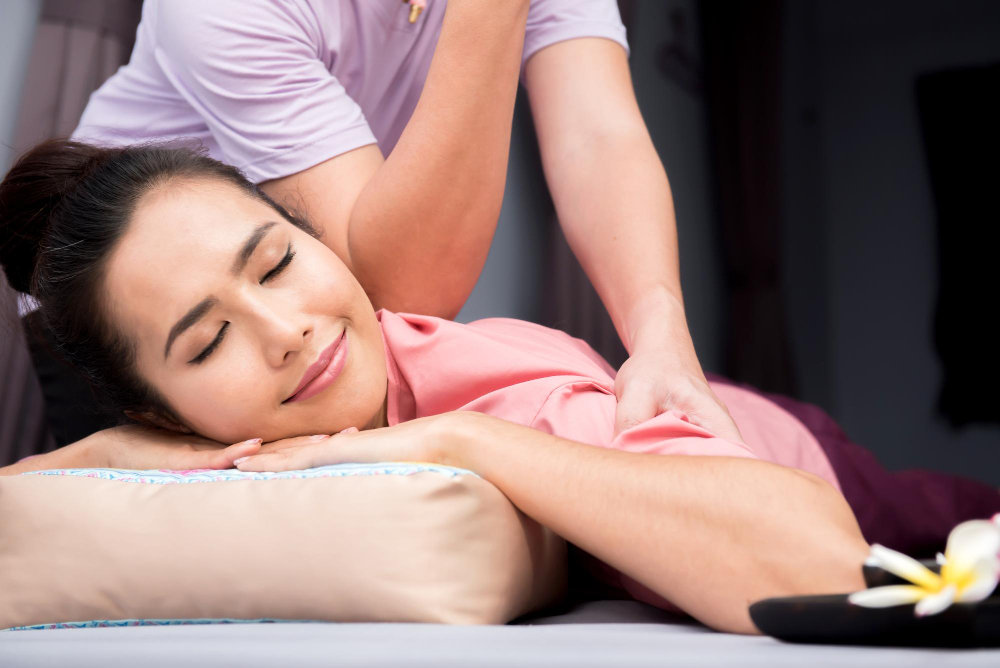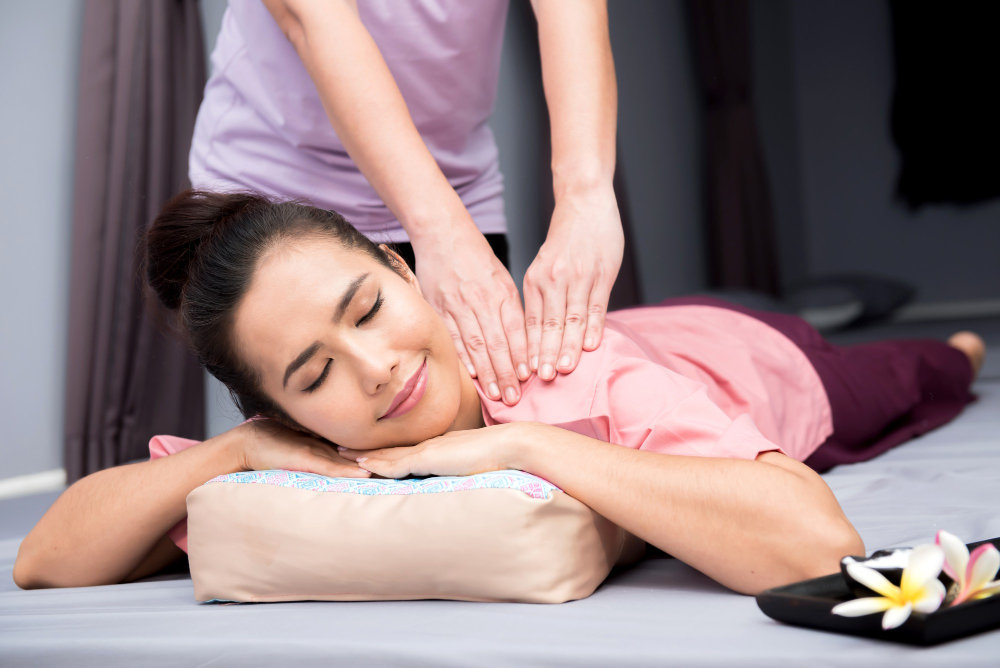What Is Thai Massage. Exploring the Benefits and Techniques

Thai massage, also known as Nuad Bo-Rarn, is a traditional healing practice that originated in Thailand over 2,500 years ago. Rooted in the principles of Ayurveda and Chinese medicine, Thai massage is a unique blend of passive stretching, acupressure, and energy work. Unlike other massage techniques, Thai massage is performed on a mat on the floor, with the recipient fully clothed in loose and comfortable clothing. This ancient healing art is not only a therapeutic treatment but also a spiritual practice that aims to balance the body, mind, and spirit.
What is Thai massage and what is included in a Thai Massage?
A typical Thai massage session lasts for about 2 hours and includes a variety of techniques and movements. The practitioner uses their hands, thumbs, elbows, knees, and feet to apply pressure and stretch the recipient’s body. The massage begins with a warm-up phase, where gentle rocking and rhythmic compressions are used to relax the body and prepare it for deeper work. The practitioner then moves on to a series of yoga-like stretches, manipulating the recipient’s body into various positions to improve flexibility, release tension, and stimulate the flow of energy.
Throughout the session, the practitioner also applies acupressure to specific points along the body’s energy lines, known as Sen lines. By applying pressure to these points, blockages are released, allowing energy to flow freely and promoting physical and emotional healing. The massage concludes with a cool-down phase, where the body is gently rocked and stretched to bring it back to a state of relaxation.
Benefits of Thai Massage
Thai massage offers a wide range of benefits for both the body and mind. One of the primary benefits is its ability to improve flexibility and range of motion. The stretching techniques used in Thai massage help to lengthen and loosen muscles, tendons, and fascia, promoting increased mobility and reducing the risk of injury. Regular Thai massage sessions can also help to alleviate chronic pain, such as back pain, by releasing tension and improving circulation.
In addition to its physical benefits, Thai massage is also highly effective in reducing stress and promoting relaxation. The rhythmic movements and deep pressure applied during the massage help to calm the nervous system and activate the body’s relaxation response. This can result in a deep sense of tranquility and overall well-being. Thai massage has also been found to improve sleep quality, boost the immune system, and enhance mental clarity and focus.
The History and Cultural Significance of Thai Massage
Thai massage has a rich history and cultural significance in Thailand. It is believed to have been developed by Jivaka Kumar Bhaccha, a physician and contemporary of Gautama Buddha. Jivaka Kumar Bhaccha is revered as the “Father Doctor” in Thailand and is considered the originator of Thai traditional medicine. Thai massage was initially practiced in temples as a form of spiritual healing and was passed down through generations by Buddhist monks.
Over time, Thai massage became an integral part of Thai culture and was used to treat a wide range of ailments. It was not until the 19th century that Thai massage started to gain recognition outside of Thailand. Today, Thai massage is practiced worldwide and continues to be a popular form of alternative therapy for its unique blend of physical and spiritual benefits.
Why Thai Massage is Famous Worldwide
Thai massage has gained popularity worldwide due to its many unique qualities and benefits. Unlike other forms of massage, Thai massage combines elements of yoga, acupressure, and energy work, making it a holistic and comprehensive healing practice. The stretching techniques used in Thai massage are particularly beneficial for athletes, dancers, and individuals with tight muscles or limited range of motion.
Thai massage is also famous for its ability to balance the body’s energy and promote overall well-being. By working on the body’s energy lines and acupressure points, Thai massage helps to release blockages and restore the flow of energy throughout the body. This can result in improved physical health, emotional balance, and mental clarity.
Furthermore, Thai massage is known for its deeply relaxing and rejuvenating effects. The combination of rhythmic movements, deep pressure, and passive stretching induces a state of deep relaxation, allowing the body and mind to release stress and tension. This makes Thai massage a popular choice for individuals seeking a therapeutic and transformative experience.
Techniques Used in Thai Massage
Thai massage incorporates a variety of techniques and movements that are unique to this ancient healing art. Some of the key techniques used in Thai massage include:
- Sen Line Compression: The practitioner applies rhythmic and firm pressure along the body’s energy lines, known as Sen lines, using their hands, thumbs, elbows, and knees. This helps to release blockages and restore the flow of energy.
- Yoga-Like Stretching: The recipient’s body is manipulated into various positions, similar to yoga poses, to stretch and lengthen muscles, improve flexibility, and increase range of motion.
- Acupressure: The practitioner applies pressure to specific points along the body’s energy lines, using their thumbs, palms, or elbows. This helps to relieve pain, promote relaxation, and stimulate the body’s natural healing processes.
- Rocking and Rhythmic Movements: The practitioner uses gentle rocking, shaking, and rhythmic compressions to relax the body, prepare it for deeper work, and promote overall relaxation.
How Often Should You Get a Full Body Thai Massage?
The frequency of Thai massage sessions depends on individual needs and preferences. Some individuals may benefit from weekly or bi-weekly sessions, while others may find monthly sessions sufficient. Factors such as physical activity level, stress levels, and specific health concerns can also influence the frequency of Thai massage.
It is important to listen to your body and pay attention to how you feel after each session. If you experience significant improvements in flexibility, mobility, and overall well-being, you may choose to continue with regular sessions. On the other hand, if you feel sore or fatigued after a session, you may need to allow more time for your body to rest and recover before scheduling another session.
Ultimately, the frequency of Thai massage sessions should be determined based on your individual needs, goals, and budget. Consulting with a qualified Thai massage therapist can help you determine the optimal frequency for your specific situation.
Preparing for a Thai Massage Session
To fully benefit from a Thai massage session, it is important to prepare both physically and mentally. Here are some tips to help you prepare for your Thai massage:
- Wear Loose and Comfortable Clothing: Thai massage is performed fully clothed, so wearing loose and comfortable clothing will allow the practitioner to move and stretch your body more effectively.
- Arrive Hydrated: It is recommended to drink plenty of water before your session to ensure your muscles are well-hydrated and flexible.
- Communicate with Your Therapist: Before the session, communicate any specific concerns, health conditions, or preferences you may have with your therapist. This will help them tailor the massage to your individual needs.
- Eat a Light Meal: It is best to avoid eating a heavy meal before your Thai massage session. Opt for a light meal or snack at least an hour before your appointment.
Finding a Qualified Thai Massage Therapist
To ensure a safe and effective Thai massage experience, it is important to find a qualified and experienced Thai massage therapist. Here are some tips to help you find the right therapist:
- Research Credentials and Training: Look for therapists who have received formal training in Thai massage from reputable schools or institutions. Check for certifications or accreditations that demonstrate their expertise.
- Ask for Recommendations: Seek recommendations from friends, family, or healthcare professionals who have had positive experiences with Thai massage therapists.
- Read Reviews: Look for online reviews or testimonials to gain insight into other clients’ experiences with the therapist you are considering.
- Trust Your Intuition: Trust your instincts when choosing a Thai massage therapist. If something doesn’t feel right or you don’t feel comfortable, it is best to find another therapist who aligns better with your needs.
Conclusion and Final Thoughts
Thai massage is a centuries-old healing practice that offers a wide range of benefits for the body, mind, and spirit. Its unique blend of stretching, acupressure, and energy work makes it a holistic and comprehensive healing modality. From improving flexibility and alleviating chronic pain to promoting relaxation and balance, Thai massage has gained worldwide recognition for its transformative effects.
Whether you are seeking physical healing, stress relief, or a deep sense of relaxation, Thai massage can be a powerful tool on your wellness journey. By finding a qualified Thai massage therapist and scheduling regular sessions, you can unlock the secrets of Thai massage and experience its many benefits firsthand. Take the time to explore this ancient healing art and discover the profound impact it can have on your overall well-being.
Now you know what is Thai massage and if you’re ready to experience the transformative benefits of Thai massage, schedule a session with a qualified therapist today. Unlock the secrets of Thai massage and embark on a journey of healing and self-discovery.
